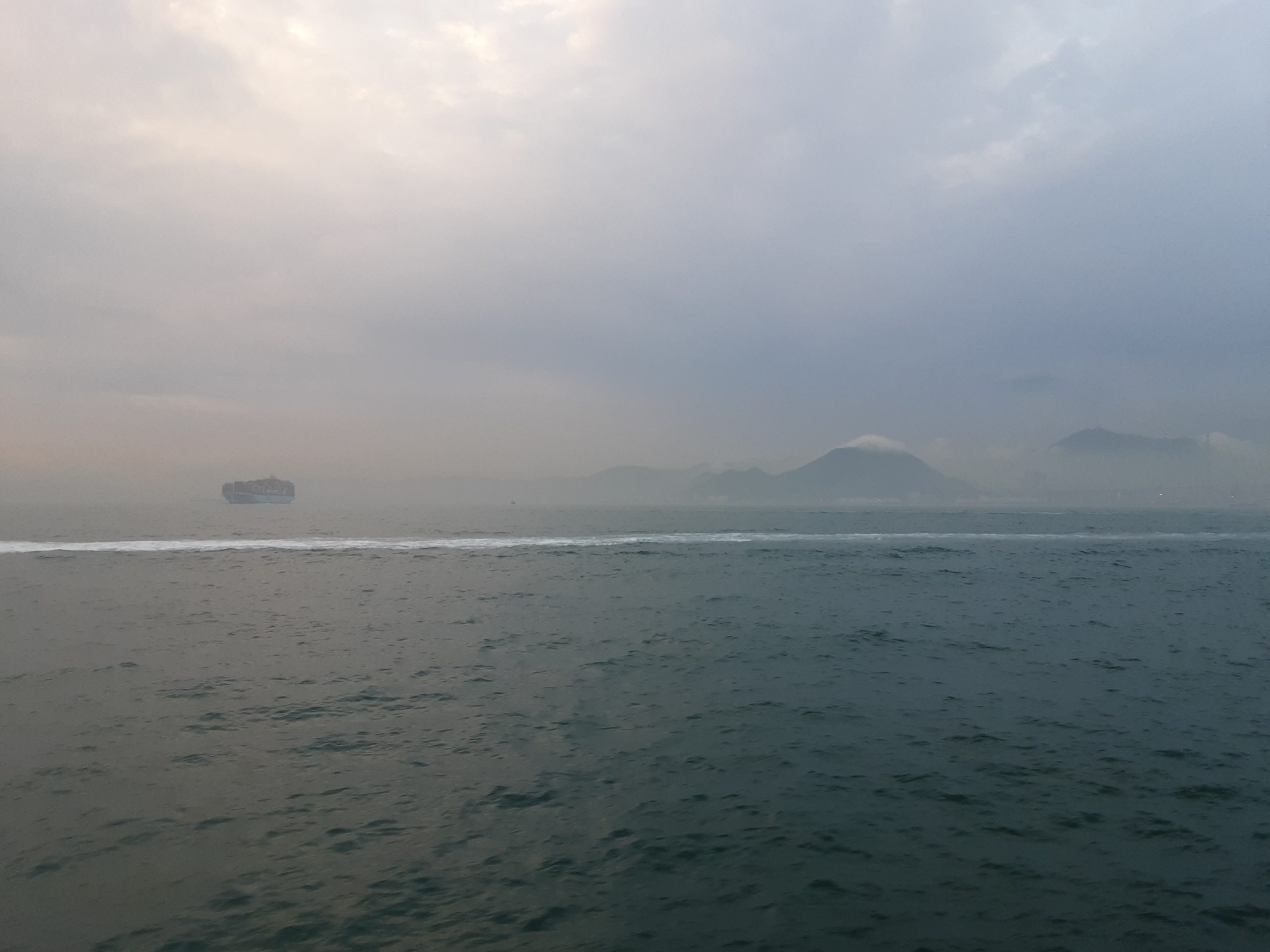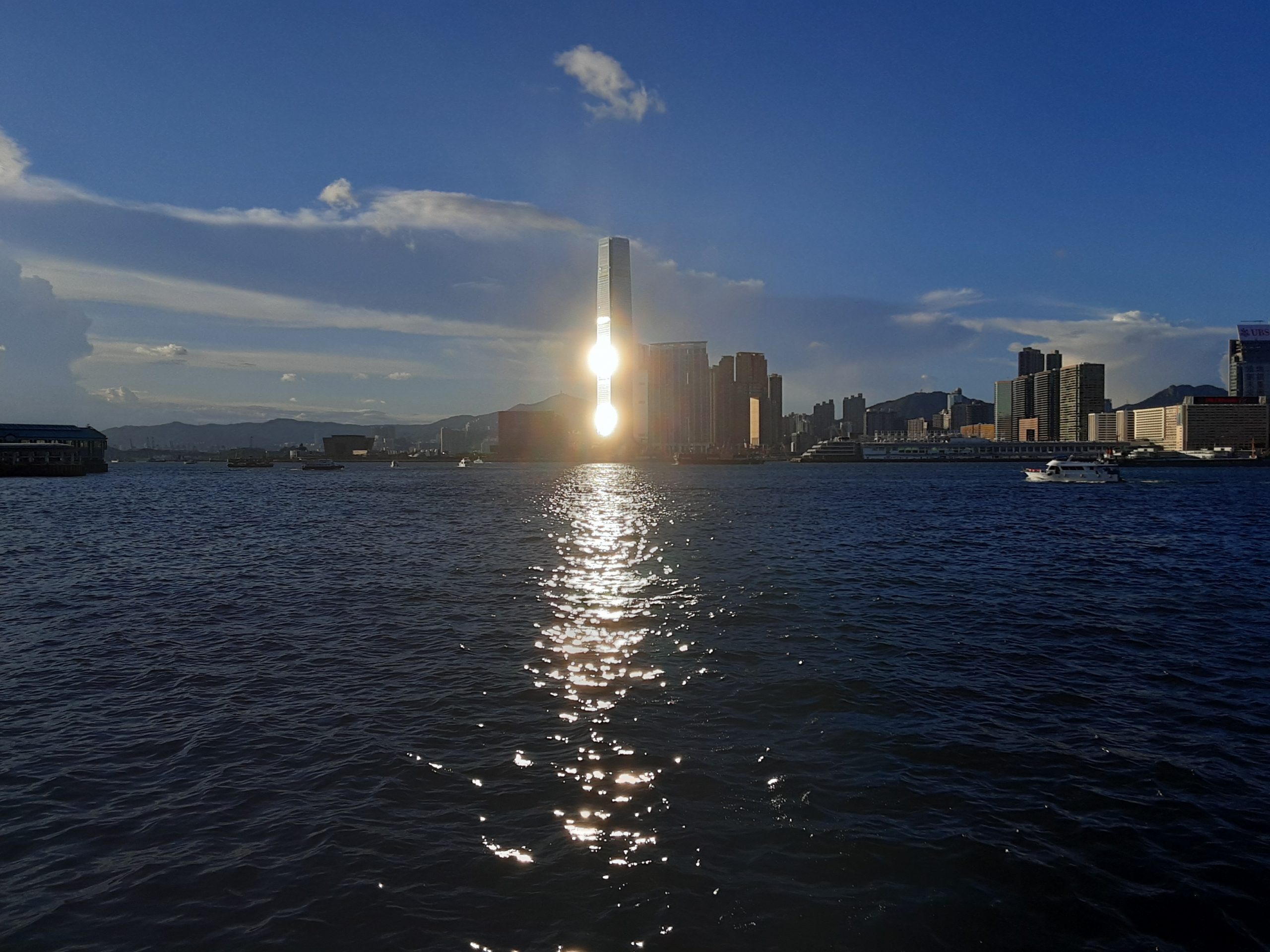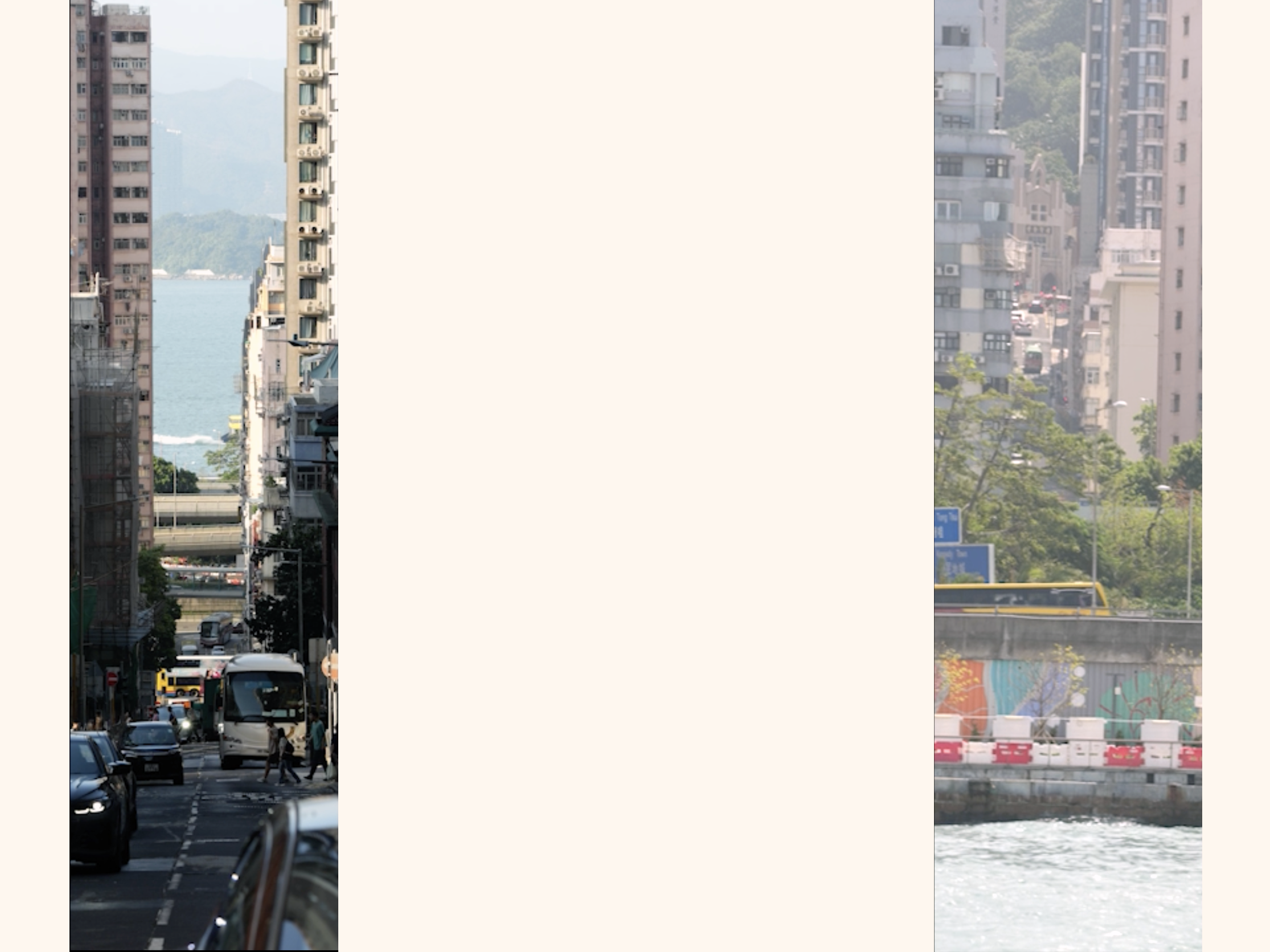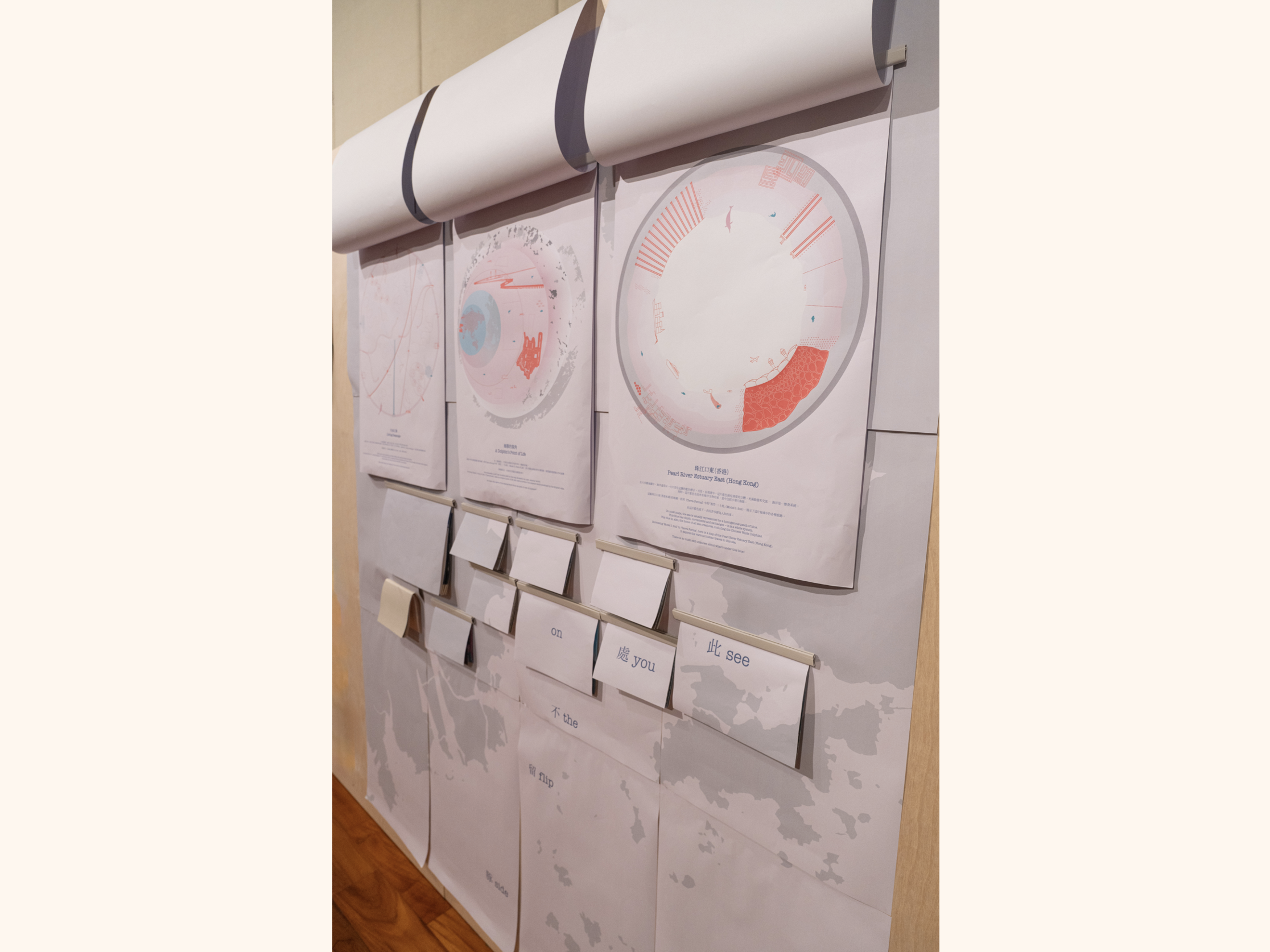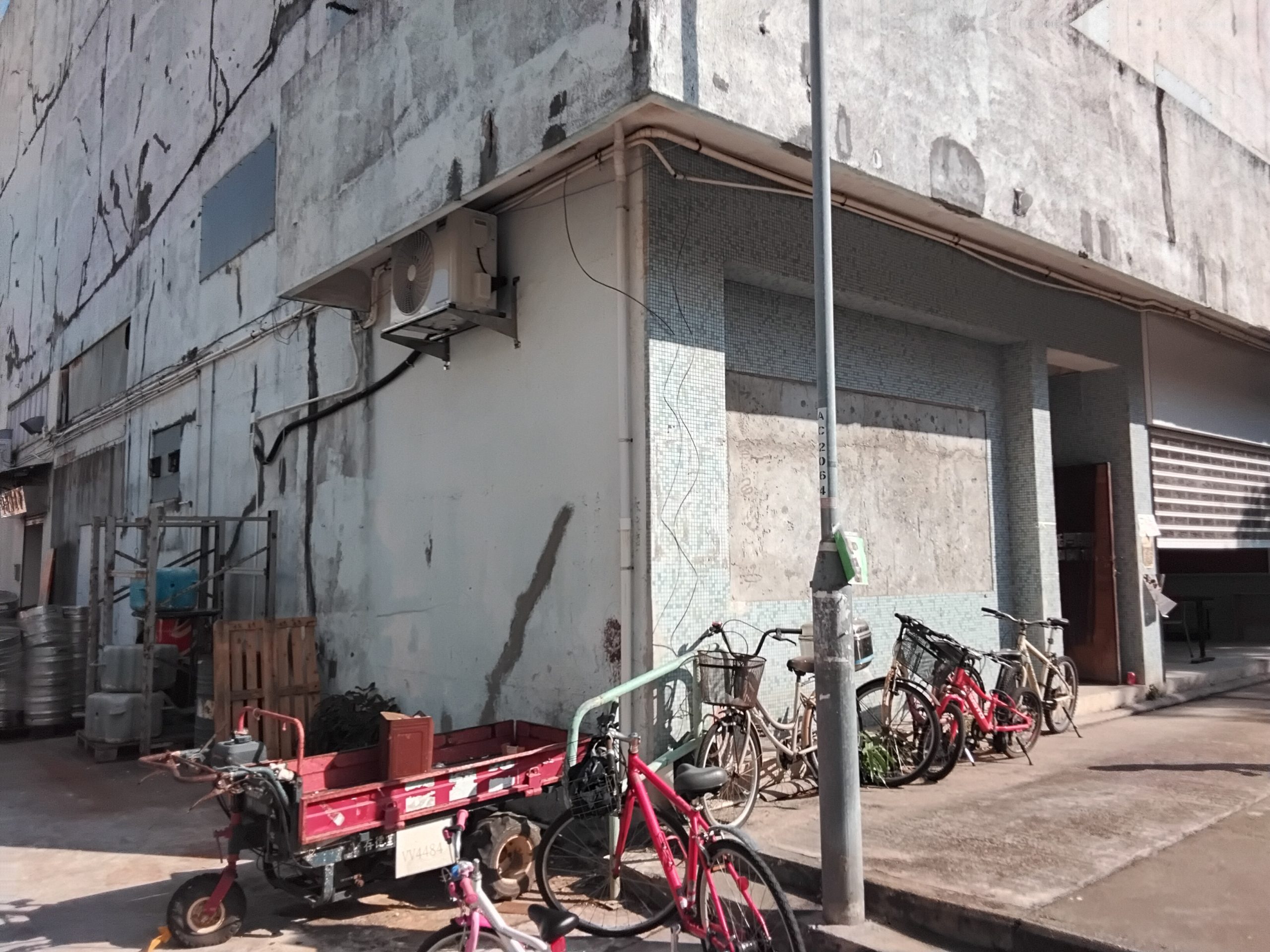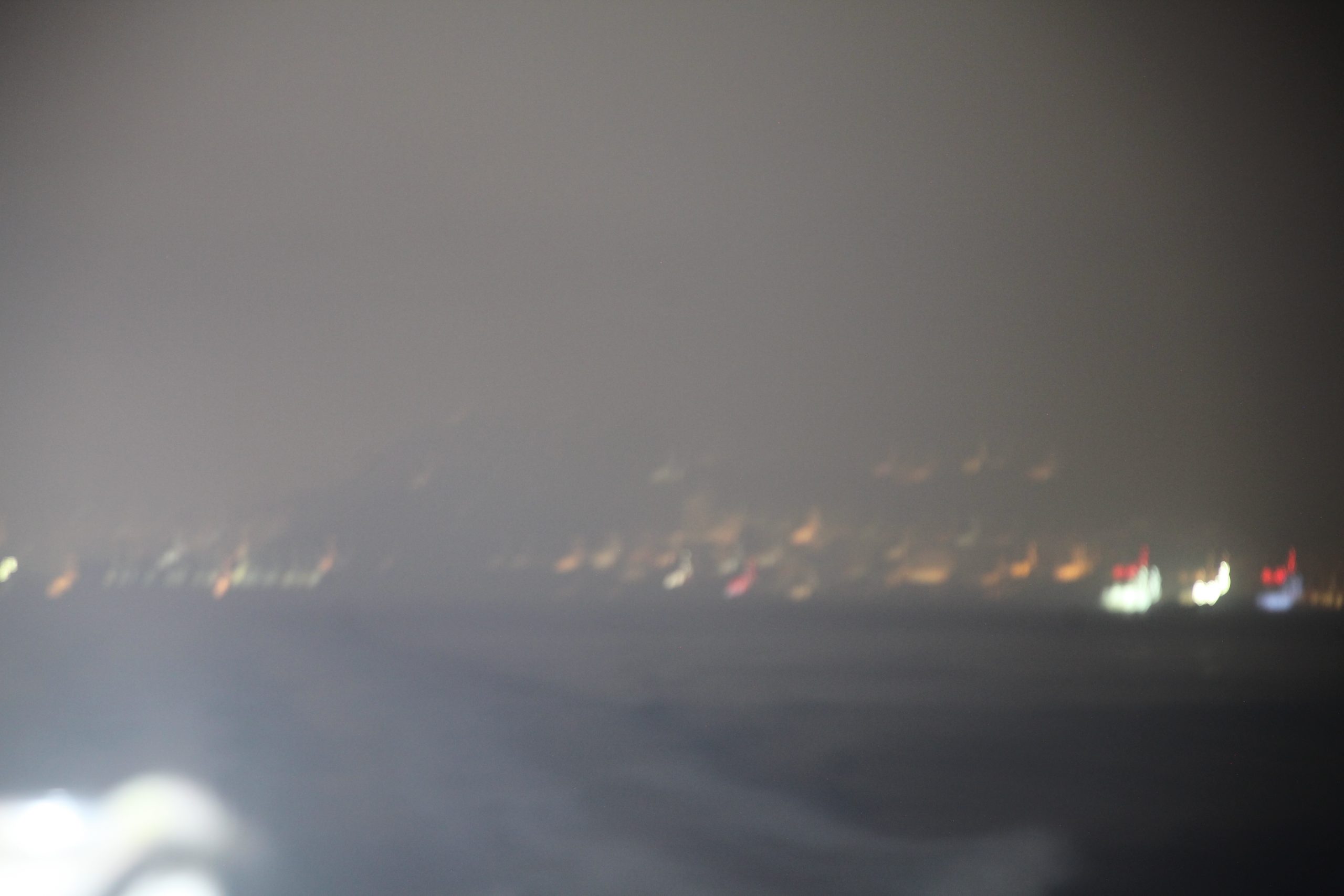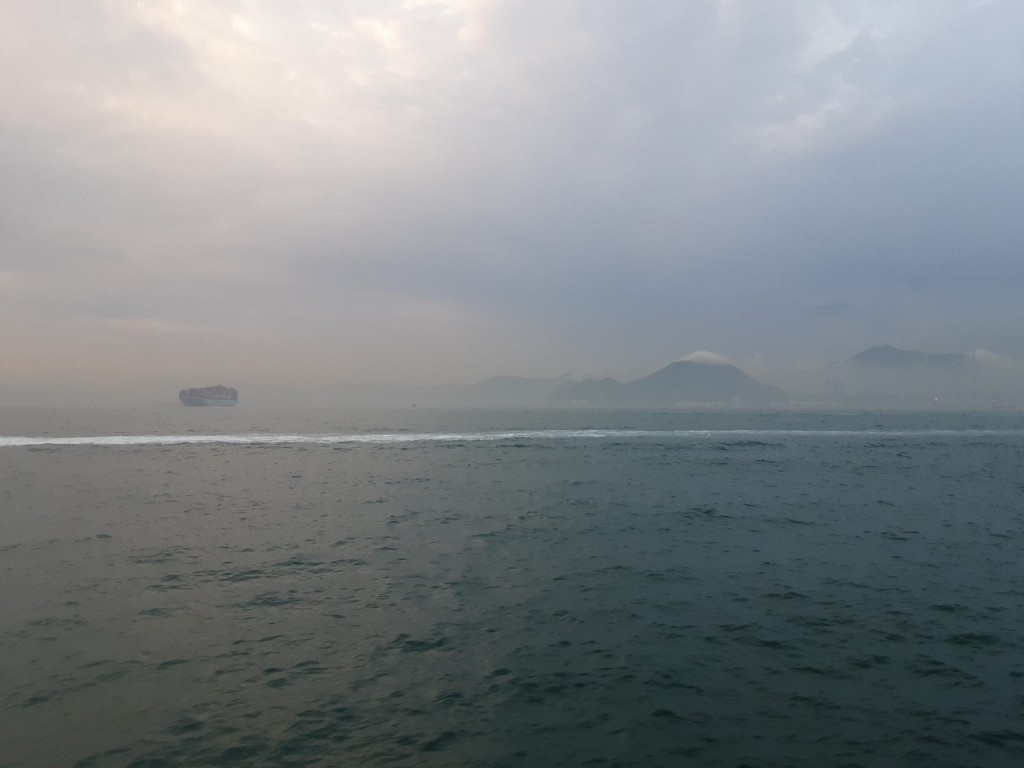
A solo exhibition by Yip Kai Chun
Curated in conversation with Clarissa Lim
15 November –21 December 2025
1–7pm Thu–Sun (or by appointment)
at Peng Chau Cinema (15 Wai Tsai St, Peng Chau)
在海上畫一條線,意味著什麼?
對葉啟俊而言,這個問題既詩意,也極為個人——是一場關於我們如何在島嶼與城市之間航行、棲居與記憶的沉思。
在離島坪洲生活逾八年,葉啟俊漸漸發現,渡輪不僅是一種交通工具,而是一艘承載時間、空間與經驗的船——一種每日往返的行動,既連結,也分隔。居於島上,意味著在城市的邊緣見證它的變遷——一次又一次地描繪、重繪我們的來往與歸途。
《浮線日誌》匯集了六件錄像、聲音與拾得物作品,把歷史悠久的坪洲戲院轉化為一處沉思之所——陸與海交會之間,他(與我們)對歸屬的感知被重新描繪。這條線遊走於停留與穿越之間,也指涉「家」與「離開」之間的必然可能。
由林凱琍策展,展覽如一系列相遇展開——在人與非人、靜與動、記憶與地景之間。透過這溫柔的繪圖,我邀請觀者思考:我們如何劃定、跨越、並棲居於這些不斷變動的世界邊界。
相關活動
開幕酒會15.11.2025 (六)4pm-6pm
海洋視覺 – 與Caroline Ha Thuc博士對談 2025.12.06 (六) 17:00-18:30 (主辦: 南灣書店) 登記
藝術家與策展人對談2025.12.20 (六) 16:00-17:30
What does it mean to draw a line across the sea? For Yip Kai Chun, this question is both poetic and personal—a rumination on how we navigate, inhabit, and remember the spaces between islands and the city.
Having lived on the outlying island of Peng Chau for over eight years, Yip have come to see the ferry not just as transport, but as a vessel of time, space, and experience—a daily act of crossing that connects and divides. To live on an island is to witness the city’s transformation from its edge—to trace and retrace our own crossings.
How to draw a line across the sea? brings together six works in moving image, sound, and found objects, transforming the historic Peng Chau Cinema into a contemplative site where land and sea meet, and where Yip’s (and our) sense of belonging is redrawn. It traces the line between standing still and passing by—or the notion of home and the inevitable possibility of leaving it.
Curated in conversation with Clarissa Lim, the exhibition unfolds as a series of encounters—between human and nonhuman, stillness and motion, memory and geography. Through this gentle mapping, Yip invite visitors to contemplate how we mark, cross, and inhabit the shifting edges of our world.
Public Programmes
Opening Reception: 15.11.2025 (Sat) 4pm-6pm
Oceanic Perspective: A Conversation with Dr Caroline Ha Thuc: 2025.12.06 (Sat) 17:00-18:30 (Organised by: Nam Wan Bookshop) Register
In Conversation: Yip Kai Chun with Clarissa Lim: 2025.12.20 (Sat) 16:00-17:30
在西邊街見到船輪、在船上見到西邊街。《對聯:合相一𣊬》的參考圖片
View the ferry from Western Street and Western Street from the ferry. Impression for 'Couplet: Perfect Alignment, an Instance'
《地圖:此處不留豚》的早期版本,與嶺南大學崔驛選博士合作
Early iteration of 'Map: See you on the flip side!' created in collaboration with Dr Scott Chui, Science Unit, Lingnan University
策展說明
〈浮線日誌〉是葉啟俊的個人展覽,展出六件取材自陸地與海洋交界的作品。展覽繞過視「離島」為「世界以外」的浪漫想像,追溯劃分海洋界線的第一步,思索在世界畫上標記和「線」的舉措。作品叩問:誰可在自然地貌(海貌?)中畫上這些無形的線?
是次展覽的靈感,源於葉氏在乘搭渡輪,向外凝望香港的海岸線時,在海上忖思「家」的概念。他在居於離島坪洲八年半的日子,早已沉浸於島上的潮浪節拍。展覽的作品細味渡輪上時間流逝的同時,亦為藝術家對住在島上的這段「過渡」時間的沉思:一個地方需要多久方能成為「家」?
坪洲縱然遠離香港市中心,但島上居民卻能在乘坐渡輪時,見證香港島與九龍半島西面永無止境的海岸及基建發展。「往返坪洲與中環的渡輪,有如在香港中間劃破一道平日鮮見的橫切面。」葉氏觀察道。
展覽以拾得物、流動影像與平面作品,穿透那道將人與海分離的頑固海岸景觀。船上乘客未必會真正的觸碰大海;要真正的與海接觸,人就必須跨過這道海岸的界線。
「相遇」可謂是次展覽的中心。葉氏追尋與「他者」相遇,一方面抖動地在靜待相遇,另一方面引發對「界線」的新理解。哲學家格里桑(Édouard Glissant)曾寫道,相遇是去面對不同的現實,然後將其融入自身的世界觀之中。葉氏思索,島上居民親眼目睹西九的變遷,是在不斷重塑我們對香港這座羣島的記憶,當中包括模糊甚或錯誤的印象。他為自己畫了一條連到「羣島」另一邊的線,抵達我城羣島的想像,以應對島上居民無可避免的流動:登船前往香港的另一個島嶼,拼湊一次又一次的相遇。
〈浮線日誌〉中的每一件作品,均為兩個島嶼之間的航程添上新一層涵義,有如為我城海陸發展的歷史添上綦繁的注腳。葉氏由渡輪向外望向香港這座羣島,創造了多重交疊的新地圖繪製方式。展覽提醒:人與深邃難測、暗不透光、具有感知、無法用地圖勾勒的灰綠色海洋相遇時,需心生崇敬。
林凱琍,2025年10月
Curatorial Note
‘How to draw a line across the sea?’ is a solo exhibition by Yip Kai Chun, featuring six pieces emerging in between the land and sea. Confronting the romantic visage of the ‘outlying island’ from the ‘rest of the world’, the exhibition challenges the very first step of demarcating our seas—to question the act of mark-making, of imprinting a line. The artworks evoke the question: Who has the agency to map these invisible lines onto our natural landscapes?
Yip began his process by turning outwards towards the coastlines of Hong Kong during a ferry ride, reflecting on the notion of home across seas. Having lived in Peng Chau for the past 8.5 years, Yip has subsumed himself in the sensorial rhythms on the island. By examining the passage of time aboard the ferry, the works in this exhibition also question this transitional moment for the artist. How long does it take for a place to become home?
Living on Peng Chau, an island lying outside the urban centre of Hong Kong, is to have a front-row view of the unrelenting coastal development and infrastructure along the western coastline of Sai Wan in Hong Kong Island and the West Kowloon peninsula. ‘The ferry shuttling between Peng Chau and Central carves a cross-section of Hong Kong seldom glimpsed on ordinary days,’ Yip reflects.
Through found creatures, moving images, and prints, the exhibition reframes hardened visions of the waterfronts that separate our bodies from the ocean. Although the act of ferrying in and out is atop the water, we barely touch it. To physically encounter the sea, we must now deliberately cross the line of the shore.
The notion of ‘encounter’ is at the heart of this exhibition. Yip seeks to encounter the other—to tremble in anticipation of meeting and to shake up one’s spirit with new readings of the line. Philosopher Édouard Glissant writes that to encounter is to confront a different reality and then bring it into one’s own worlding. Yip reflects on the how the act of bearing witness to West Kowloon’s development artworks do reshapes our (mis)remembering of our archipelago. He draws his own line to the other side of the ‘archipelago’ that is our world and contends with the very exchange we do daily as islanders: to hop onto a ferry, to set sail for the other islands of Hong Kong, pieced together one encounter at a time.
Each artwork draws another layer over the journey between two islands. Turning outwards beyond the ferry to the archipelagic Hong Kong, Yip creates a palimpsest of renewed map-making, each work a notation that complicates the history of development between land and sea. Navigating between still and moving images, cosmographs and found creatures, ‘How to draw a line across the sea?’ invokes the reverence of our encounters with the fickle waterbody, a deep, often opaque, greenish-grey, sentient body, seemingly impossible to map.
Clarissa Lim, October 2025
船上隨筆
一.
住了一個地方多久才會稱它為「家」?住了在坪洲八年半,卻記不起從何時開始,認定坪洲是「家」。它的節奏、距離、氣味和動靜都慢慢變得自然不過。在動盪之中,很多從未想過會變的東西都瓦解起來,例如「家」。
坪洲也不會永遠是一個「家」。那麼,住在島上的這八年半, 可能只是一個階段,又或者是一個相當漫長的駐留計劃?
每完成一個駐留計劃,我都強逼自己遺下一點和那個地方相關的創作。那麼,長達八年半的駐留計劃該留下些甚麼?要是我有朝一日不再住在坪洲,坪洲會留下甚麼痕跡?我最懷念的會是甚麼?
二.
承托着坪洲很多美妙而已然習以為常的人事物的,是坐船。頭一兩個月搬入坪洲坐船時的滿足感,只要有幾日沒坐還能感受得到。
來往坪洲和中環的渡輪,在香港畫了一個平日鮮見的橫切面。和飛機一樣,渡輪也將出發地和目的地分隔,中間是有如獨立於兩者的中途。
渡輪是兩個時空、兩種節奏、兩種生活的過渡;坐船是待機、調息、緩衝。它是一個空間、一個經驗。幾乎分秒不差的渡輪,也為坪洲的生活定立嚴謹穩定的規律。
說得出和說不出名字的大小島嶼與船隻,在有如一格格菲林的長形窗口中慢慢墜後,也像一幅卷軸。不知這算入神還是出神:這幅卷軸畫的確百看不厭。
三.
為着這次展覽,我逼自己在每一次坐船時,不要用電腦工作,不要看書,不要閉目靜觀,只專心感受坐船的每一刻,並在每一程船發掘到新的東西——大概是另一種靜觀?
四.
這樣的一個過期逗留的「駐留計劃」的「成果」,依附在坪洲戲院這棟歷史建築的售票處。
戲院沒有塗脂抹粉的「活化保育」,保留了應有的舊日痕跡。現在,它正在以新的身份與這個地方建立新聯繫。
作品必須與這些過去和現在的痕跡共處,可以是寄生,可以是接枝,也可以是滲透。
五.
現在,我沒有離開坪洲的打算 — 這個漫長的駐留計劃還在繼續進行。也許,這次展覽是一個尋回「本心」的練習。除了是初搬入坪洲和坐船的好奇,也是創作的樂趣和純粹。
這也可能是個強逼自己去想「別離」的練習。畢竟,一切都有終結之時,而且總有超出自己想像之外的時侯。
也許,這不但適用於坪洲,也適用於所有的「家」,所有與我有所連繫的地方。
葉啟俊,2025年8月23-24日
Reflections Aboard the Ferry
I.
How long must one dwell in a place before calling it “home”? Having lived on Peng Chau for eight and a half years, I cannot recall when I first came to regard it as such. Its rhythm, distances, scents, and sounds gradually became utterly natural. Amidst upheaval, many things I never imagined would change have crumbled away—like the concept of “home”.
Peng Chau, too, will not remain a “home” forever. So, these eight and a half years on the island—were they merely a phase, or perhaps an exceptionally lengthy residency programme?
Upon completing each residency, I force myself to leave behind some creative work connected to that place. So what should remain from this eight-and-a-half-year residency? Should I one day cease living on Peng Chau, what traces would the island retain? What would I cherish most?
II.
The ferry ride underpins much of Peng Chau’s beauty—the people, the things, the routines we’ve grown accustomed to. That sense of fulfilment from boarding the ferry during my first few months on Peng Chau remains palpable even after a few days’ absence.
The ferry shuttling between Peng Chau and Central carves a cross-section of Hong Kong seldom glimpsed on ordinary days. Like aeroplanes, ferries separate departure points from destinations, with an intermediate space that seems detached from both.
The ferry is a transition between two times, two rhythms, two lives; travelling by boat is a pause, a breath, a buffer. It is a space, an experience. The mostly punctual ferries establish a strict, steady rhythm for Peng Chau life.
Islands and vessels, both named and nameless, drift slowly past through the elongated windows like frames of film, unfurling like a scroll. Whether this counts as rapt attention or absent-mindedness, this scroll painting truly never grows tiresome.
III.
For this exhibition, I compelled myself on each ferry crossing to refrain from working on my computer, reading, or closing my eyes in meditation. Instead, I focused solely on experiencing every moment of the journey, discovering something new on each voyage—perhaps another form of contemplation?
IV.
The ‘outcome’ of this extended residency programme clings to the ticket office of Peng Chau Cinema, a historic building. The theatre has avoided cosmetic revitalisation and conservation, preserving its traces of the past. Now, it is forging new connections under a new identity.
The work must coexist with these traces of past and present—parasitic, grafted, or permeating.
V.
For now, I have no intention of leaving Peng Chau—this protracted residency continues.
Perhaps this exhibition is an exercise in rediscovering one’s ‘pure intent’. Beyond the initial curiosity of moving to Peng Chau and taking the ferry, it is also about the joy and innocence of creation.
It may also be an exercise in compelling myself to contemplate ‘parting’. After all, everything has its end, and there are always moments beyond one’s imagination.
Perhaps this applies not only to Peng Chau, but to all ‘homes’—all places connected are to me.
Yip Kai-chun, 23-24 August 2025
創意團隊
藝術家: 葉啟俊
策展及視覺設計: 林凱琍
監製: 林玥臻
製作: 豉油 soy sauce!
技術製作(卷軸:銀河): 鄧志韜
合作方
資助: 香港藝術發展局 *
場地伙伴: 坪洲戲院
鳴謝
朱穎詩
黃毅勞
陳家禮
楊秀卓
鄭智雄
鄧文嫦
馮錦霖
陳劍雄
周美寶
陳蕙芳
崔驛選博士
青花工作室
坪洲所有人
* 香港藝術發展局支持藝術表達自由,本計劃內容並不反映本局意見。
Creative Team
Artwork: Yip Kai Chun
Curation & Visual Design: Clarissa Lim
Producer: Gloria Furness
Fabrication: 豉油 soy sauce!
Technical Production (Scroll I: Milky Way): Tobias Tang
With the Support of
Supported by: Hong Kong Arts Development Council*
Venue Partner: Peng Chau Cinema
Special Thanks
Chu Wing Sze
Wong Ngai Lo
Tea Chan
Ricky Yeung
Bacon Cheng
Sherman Tang
Tony Fung
Chan Kim Hung
Rebecca Chow
Fongie
Dr Scott Chui
Seika Studio
Everyone on Peng Chau
* The Hong Kong Arts Development Council supports freedom of artistic expression. The views and opinions expressed in this project do not represent the stand of the Council.

